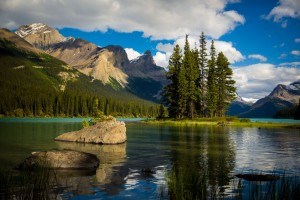
Parks Canada has accepted Maligne Tours Ltd.’s proposal for redevelopment at Maligne Lake, but has said no to the 66-room hotel that was the plan’s flagship development.
On July 25 environmental advocates welcomed the decision to reject the heritage-style accommodation, but many had significant concerns about what was approved, namely the 15 tent cabins the company hopes to build on the hillside below the Maligne Lake Chalet.
“Yes, they’ve turned down the hotel, but we’ve still got these tent cabins, which are quite frankly like a Trojan horse,” said Jill Seaton of the Jasper Environmental Association. “I’m afraid [a hotel could] still be there in the future because they’ve got the door open with these tent cabins.”
Although a concern for some, Pat Crowley, the general manager of Maligne Tours Ltd., said that even if the cabins do get built, they will just be one small, “low-key” part of the overall development and won’t have a major impact on visitation.
Crowley called Parks’ decision “good news” and said the company is looking forward to taking the next steps in the development process in order to implement the 13 proposals that received Parks approval. Included in those approvals is a wildlife-themed maze, earth-caching, storytelling experiences and enhanced boat tours to Spirit Island.
While discussing Parks’ decision, July 25, Supt. Greg Fenton explained that, although the agency couldn’t approve the hotel—on the basis that the potential visitor experience didn’t outweigh the environmental impacts—tent cabins are different.
“[The] potential negative impact of tent cabins is much less,” he said, noting they’re smaller in scale and they aren’t permanent buildings.
Fenton said he believes all of the approved elements of the proposal have the potential to connect Canadians to the park and to enhance visitor experiences, while giving visitors an opportunity to enjoy one of Jasper’s iconic landscapes.
But, despite those possible benefits, the proposal’s opponents aren’t convinced.
The Canadian Parks and Wilderness Society (CPAWS), which condemned Maligne Tours’ proposal in its recent State of Canada’s Parks report, has also raised concerns, especially about the possibility of setting a dangerous precedent.
“Essentially, right now, the [park’s] management plan prohibits any new land from being released for outlying commercial accommodation, and so they’d have to release land in order for this to happen,” said Danielle Pendlebury, conservation coordinator for the northern Alberta chapter of CPAWS.
“By making an exception, and essentially amending the management plan for this accommodation, Parks Canada is essentially opening the floodgates to pick more proposals for outlying commercial accommodation. That’s our concern, is that it’s setting a precedent that some proposals can go through.”
Pendlebury said CPAWS is also troubled by many of the recreational activities approved in Parks’ decision.
She said many of them “are more appropriate for a theme park than a national park,” and cited a 2010 Parks report that found Canadians are most attracted to national parks because of their pristine nature and wildlife, and less because of their “attractions.”
CPAWS is also worried that developments like the exploratory maze and enhanced boat tours will leave a footprint at the lake, putting its sensitive environment in jeopardy.
The Maligne Valley is home to the park’s smallest caribou herd—tallying only four animals—and is a major corridor for grizzly bears, a threatened species in Alberta. It’s also important harlequin duck habitat. Pendlebury is worried that increased overnight visitation will disrupt these struggling animals.
Crowley said she doesn’t believe the improvements will increase visitation to the lake. Rather, she said, they will provide visitors with a more engaging experience.
“I don’t think [visitation] will change one little bit,” she said. “There are over 200,000 people coming up here every year, and they’re all keen to do something when they get here—or to learn something, or to have their children learn something—so that’s what we’ll be doing.”
And while Maligne Tours is excited by the prospect of further development at the lake, Crowley admitted that without the anticipated revenue from the heritage-style hotel, the company’s proposed experiential activities will have to be somewhat scaled down from what was laid out in the original conceptual proposal.
The heritage-style hotel would have “went a long way to [creating a] sense of place,” but the tent cabins will allow the company to provide most of the cultural and heritage presentations they had originally hoped for, she said.
“We still get to accomplish the same things in terms of visitor engagement—it will just be in a different manner.”
Crowley said Maligne Tours is eager to take the next steps in the process. That will mean utilizing the terms of reference Parks provided them to create a more detailed proposal and conduct an environmental assessment.
Another round of public engagement will follow, to help inform Parks on how to proceed.
In the meantime, Pendlebury said CPAWS will stay vigilant as the process unfolds and will continue to lobby the government to put the brakes on further development at Maligne Lake.
“We’re definitely going to be continuing with our campaign, and continuing with the petition and encouraging people to write letters and their comments to Parks Canada,” she said.
“We don’t see this as a win, we see this as the fact that there is still a huge part of the resort going through.”
Trevor Nichols and Nicole Veerman
[email protected] and [email protected]
